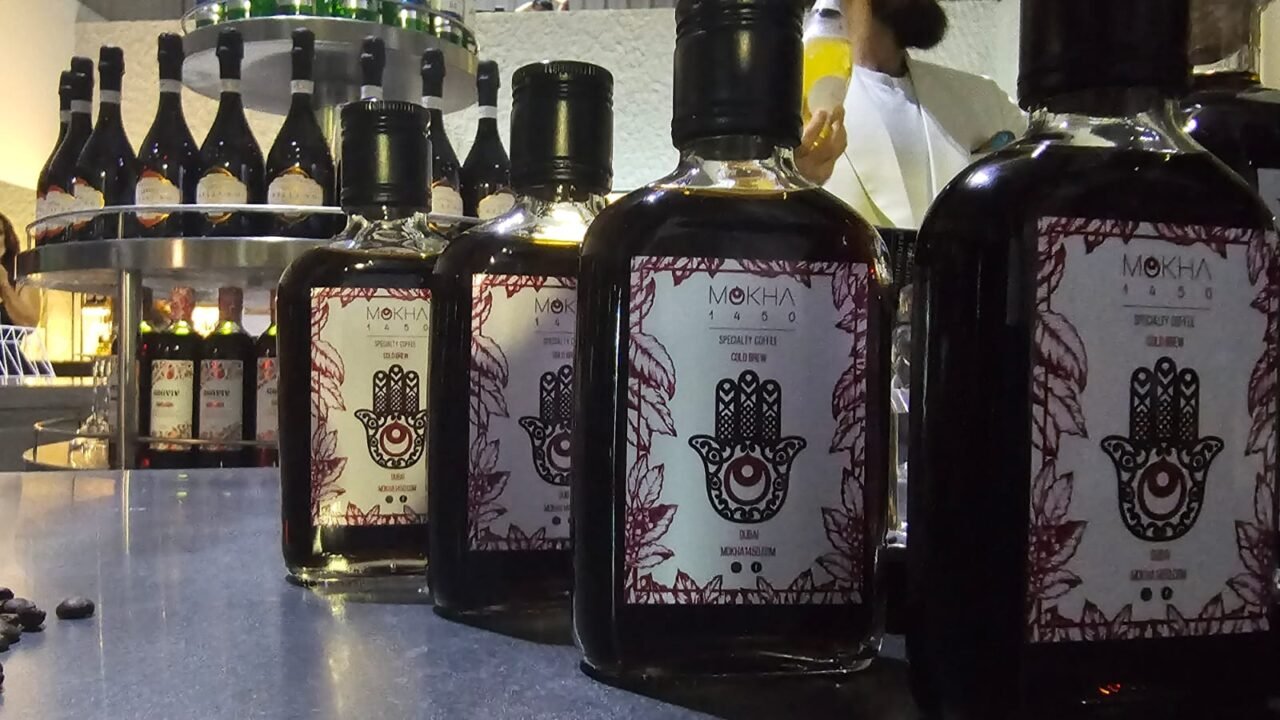تحظى القهوة المركزة بشعبية كبيرة مع النمو المتفجر للقهوة الباردة والمشروبات الجاهزة للشرب. في حين أن القهوة القابلة للذوبان هي المتصدرة من حيث الراحة، إلا أنها تفشل في تلبية الطلب على الجودة. لقد أدت الجهود المبذولة في تحسين جودة القهوة القابلة للذوبان ثمارها، ولكن الأجيال القادمة ستعتمد على القهوة المركزة.
هذا العام، أصبحت القهوة المركزة شائعة في المقاهي وعلى وسائل التواصل الاجتماعي، حيث تظهر في وصفات تتنوع بين القهوة الباردة ومشروبات الإسبريسو والمارتيني. في الوقت نفسه، تظل القهوة القابلة للذوبان قيمة سوقية قوية، حيث شكلت 25% من القهوة التي تم استهلاكها عالمياً في عام 2022.
يبدو أن للقهوة المركزة اليد العليا – توفر الراحة، والجودة، والتنوع، وسعر منافس. هل يمكن للقهوة القابلة للذوبان، العمود الفقري الطويل الأمد للقهوة المريحة، منافسة القهوة المركزة على المدى الطويل؟
“كان وجود زجاجة من القهوة المحضرة متاحة للتخفيف السريع أو الشرب السريع في ازدياد، على الأقل في السوق الأمريكية، خلال السنوات العشر إلى الخمس عشرة الماضية”، يقول مات سوينسون، نائب رئيس عمليات القهوة في شركة فارمر برذرز كوفي.
لم تكن القهوة المركزة ظاهرة فجائية – فقد كانت تصعد ببطيء. خلقت القهوة الباردة الزخم للتراكيز في الستينيات، مع إطلاق جهاز تودي للتحضير. ولكنها لم تصبح قهوة شعبية إلا في عام 2010، عندما بدأت العلامات التجارية الرئيسية في مجال القهوة المختصة تطرح منتجات القهوة الجاهزة للشرب.
خلال العقد الأخير، ازداد اهتمام المستهلكين بالقهوة الباردة بسرعة وخصصت متاجر البقالة أقساماً كاملة للقهوة الباردة والمشروبات الجاهزة للشرب.
ازداد عدد التجار الذين يحملون القهوة المركز في السنوات الثلاث الماضية، مع وجود علامات تجارية مثل ستمبتاون، لا كولومب، بلو بوتل، شاميليون، وهاي برو جزءًا من هذا الاتجاه. في عام 2023، سمحت موزعات الإسبريسو الباردة والقهوة الباردة الجاهزة على الرف بالتوسع بشكل كبير في القهوة الجاهزة للشرب والقهوة المركزة الباردة في المقاهي.
“قبل أقل من عشر سنوات، كان هناك بضعة أشخاص فقط يمكنهم إنتاج القهوة السائلة على نطاق تجاري.. الآن من الصعب تتبعها، لقد أصبحت شائعة جداً.”
في استطلاع أجري عام 2023، قال حوالي 65 % من الألفية و48% من جيل زي الأمريكيين إنهم أكثر عرضة لشراء القهوة المركزة خلال العام التالي بسبب سهولتها وتنوعها. في الواقع، ارتفعت مبيعات القهوة المركزة عبر الإنترنت بنسبة تقارب 20% في عام 2023.
“بينما دفعت الراحة في البداية اتجاه القهوة الجاهزة للشرب، يتم تشجيع المستهلكين من جيل الألفية وجيل زي على استكشاف العلامات التجارية وأساليب التحضير المختلفة من خلال وسائل التواصل الاجتماعي، خاصة في فئة القهوة الباردة”.
كما أن لديهم دخل أعلى من الأجيال السابقة وسلوك استهلاكي مختلف يجعل القهوة عالية الجودة أكثر أهمية بالنسبة لهم. ومنذ ارتفاع تحضير القهوة في المنزل خلال جائحة كوفيد-19، يحتفظ العديد من المستهلكين بمهاراتهم في تحضير القهوة في المنزل وتفضيلاتهم لجودة القهوة والاستدامة.
دخلت ثقافة القهوة المختصة في الاستهلاك الرئيسي خلال السنوات القليلة الماضية، وجيل زي هو أول جيل ينمو مع القهوة المختصة المتاحة على نطاق واسع. وهذا يعني أن هناك توقعات للمستهلك بشأن معايير الجودة الدنيا الآن.
لقد سادت القهوة القابلة للذوبان سوق القهوة المريحة لفترة طويلة – ولكنها لا تفي تمامًا بتوقعات المستهلكين بشأن الجودة. لم يكن مقصوداً أبدًا للمشروبات عالية الجودة، حيث تؤدي عملية التجفيف إلى تدهور المركبات الطعمية القابلة للتطاير بشكل طبيعي. وعلى الرغم من ذلك، فإن توفرها وسهولة استخدامها حافظا عليها في الطلب لعقود.
ولكن مع نكهة وملمس أقل حدة من مشروبات القهوة التي تعتمد على التراكيز، ستواجه صعوبة في مواكبة المطالب بالجودة.
“في حين أن القهوة القابلة للذوبان تحتفظ ببعض المركبات الصحية الموجودة في القهوة المحضرة، إلا أنها تفتقر إلى النكهات الدقيقة الموجودة في القهوة المختصة”، يقول كريشتوف بارابوس، رئيس القهوة في هارد بينز والمؤسس المشارك لهاردتانك.
على العكس من ذلك، تتميز القهوة الباردة بحموضة أقل، وطعم أكثر نعومة، وتركيزات أعلى للكافيين مقارنة بالقهوة المحضرة تقليدياً.
“تتزايد شعبية القهوة المركزة الباردة ومشروبات القهوة الجاهزة للشرب الباردة بسرعة على حساب سوق القهوة القابلة للذوبان، نتيجة للطلب المتزايد على خيارات القهوة المختصة”.
مع القهوة القابلة للذوبان التقليدية التي تلبي الطلب على الراحة ولكن تفتقر إلى الجودة، شهدت السنوات القليلة الماضية استثمارات من العلامات التجارية الخاصة بنطاق القهوة القابلة للذوبان من درجة الجودة الخاصة.
قدمت العلامات التجارية مثل فيرف، وبراود ماري، وبلو بوتل مجموعات قهوة قابلة للذوبان ممتازة، وذهبت إنتليجنتسيا حتى خطوة إضافية، حيث فتحت مقهى في كاليفورنيا تستخدم حصرًا إسبريسو قابل للذوبان.
“يمكن لقطاع القهوة المركزة الناضج تصنيع خطوط متخصصة على نطاق أصغر بكفاءة، في حين أن التركيز الكبير على حجم قطاع القهوة القابل للذوبان يشكل عاملًا محددًا لخطوط الاختصاصية”.
وفقًا لكريشتوف، فإن تجفيف القهوة القابلة للذوبان بالتجميد أو الرش يتطلب مزيدًا من المعالجة والتعبئة مقارنة بالتراكيز.
“يمكن أن يؤدي هذا العملية البسيطة لتصنيع التراكيز إلى تكاليف إنتاج أقل، بما في ذلك استخدام الطاقة المخفضة والإضافات الأقل اللازمة للحفاظ على القهوة”، يقول.
بالإضافة إلى ذلك، فإن العائد المحتمل على الاستثمار أعلى لتراكيز القهوة.
“غالبًا ما تسيطر القهوة المركزة على سعر مرتفع في السوق بسبب جودتها وتنوعها المدركين، مما يتيح للمحمصين والمصنعين تحقيق هوامش ربح أعلى مقارنة بمنتجات القهوة الفورية القياسية”.
“النمو المتفجر والابتكار الذي لاحظناه في قطاع القهوة الجاهزة للشرب يشير إلى إمكانات هائلة للتوسع واختراق السوق في المستقبل القريب.”
ومع ذلك، ليس كل شيء سيئاً بالنسبة لقطاع القهوة القابلة للذوبان الخاص. وفقًا لمات، فإن المستهلكين يغيرون نظرتهم إلى القهوة الفورية، مع اعتبارها بشكل أكثر إيجابية. وهذا يجعل الوقت مثيرًا لكل من القهوة المركزة والقابلة للذوبان.
“ما زالت القهوة الفورية المتخصصة تعيش لحظتها”، “لقد اكتسبت الكثير من الجاذبية، لكنها لم تصل إلى النضج لإصدار أي قرار نهائي بشأن ما حدث وأين كانت.”
“سوق القهوة السائلة – التراكيز والإسبريسو المركزة – تركز بشكل كبير على المستهلك الأصغر سنًا – ملينيالز أقل من 40 سنة”.
لا تزال هناك مساحة لنمو السوقين، حيث تم تقسيم الطلب والتسويق بشكل ما بين القهوة القابلة للذوبان والمركزة. بدلاً من السؤال عما الذي سيحل محل ما، يبدو أن الأمر أكثر توجهاً نحو تحديد الوضع الديموغرافي في السوق.
مع انفجار القهوة الباردة والجاهزة للشرب وقيادتها مع جيل زي، ستحقق تراكيز القهوة نجاحاً كبيراً. ولكن لا تزال هناك مساحة لنمو القهوة القابلة للذوبان المتخصصة، مستهدفة جمهوراً مختلفاً.
